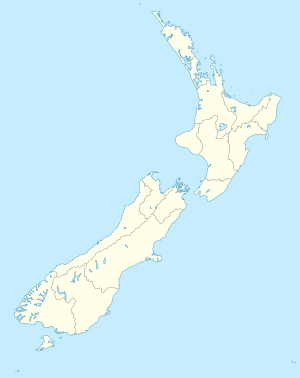Homer tunnel
| Homer tunnel | ||
|---|---|---|
|
East portal
|
||
| use | Road tunnel | |
| traffic connection | New Zealand State Highway 94 | |
| place | Fiordland National Park ( New Zealand ) | |
| length | 1270 m | |
| Number of tubes | 1 | |
| construction | ||
| start of building | 1935 | |
| completion | 1953 | |
| business | ||
| toll | toll-free | |
| release | 1954 | |
| location | ||
|
|
||
| Coordinates | ||
| East portal | 44 ° 45 ′ 54 ″ S , 167 ° 59 ′ 21 ″ E | |
| West portal | 44 ° 45 ′ 48 ″ S , 167 ° 58 ′ 24 ″ E | |
The Homer Tunnel is a road tunnel in the Fiordland region of New Zealand's South Island . It opened in 1954 and connects Milford Sound with Te Anau and Queenstown . It penetrates the main watershed of the South Island at the Homer Saddle mountain saddle between the valley of the Eglinton and the Hollyford Rivers in the east and that of the Cleddau River in the west.
The straight tunnel originally had only one lane and was paved with gravel. The tunnel walls are bare granite . The east portal is at a height of 945 m. The tunnel runs from here over 1270 m with a gradient of about 1:10 down to the west portal. Before the tunnel was enlarged and the road paved, it was the longest gravel-paved tunnel in the world.
history
William H. Homer and George Barber discovered the Homer Saddle on January 27, 1889. Homer proposed a tunnel at this point to improve access to the area around Milford Sound.
J. Cockburn of the Southland Progress League lobbied for the tunnel so government workers began work in 1935. The tunnel and the Milford Road connected to it were built as a job creation measure during the economic crisis, initially by 5 men with hoes and wheelbarrows. The men lived in tents in a mountain area, where there was no direct sunlight for six months. At least three workers were killed by avalanches in the decades that followed.
The work progressed slowly, among other things because cracks in the rock allowed melt water to penetrate. In the end, pumps and a power station were built on a nearby river to pump out 40,000 liters of water per hour. The work was interrupted by the Second World War, after the breakthrough had already been achieved in 1940. An avalanche destroyed the east entrance in 1945. The opening of the tunnel was delayed until 1954.
safety
In 2002 a bus carrying tourists from Singapore caught fire in the tunnel 150 meters from the east entrance. Passengers and drivers only had to use the headlights of the cars in front of the tunnel to get to safety through the smoky tunnel. Two tourists lost their orientation and finally left the tunnel through the far west end. Three passengers were flown to hospital for smoke inhalation. As a result, a satellite phone and fire extinguisher were installed. Two other tourist buses were destroyed by fire outside the tunnel in January and March 2008.
Lighting and a traffic light system were installed in 2004 to counter capacity and safety problems. Although the tunnel is wide enough for a bus and a smaller vehicle to meet, two busses or campers encountering each other are problematic. In addition, the traffic is concentrated in time: in the morning towards Milford Sound and in the afternoon towards Te Anau. The traffic lights are only switched on in the summer high season, as the avalanche danger in winter and spring is too great a risk to have the vehicles waiting in front of the tunnel. As the traffic on the road increases, the risk for vehicles waiting in front of the tunnel is expected to increase.
An extension of the tunnel to two full-width lanes is under discussion. Although this would reduce the risk of avalanches for waiting cars, implementation is unlikely as the road is little used on a national scale, even if it is of great tourist importance. Avalanche warning systems were installed in the area and in 2005, Transit New Zealand had a high priority in the planning of the renovation of the avalanche protection systems at the eastern access. This project would cost between NZ $ 14 million and NZ $ 15 million and is unlikely to start before the end of the decade.
Individual evidence
- ↑ a b c Homer Tunnel . In: Alexander Hare McLintock (Ed.): An Encyclopaedia of New Zealand . Wellington 1966 ( online [accessed June 5, 2018]).
- ^ A b c Milford Sound Transport - Issues and Options - Report . (PDF 2.3 MB) Management Engineering Environment , 2005, archived from the original on September 7, 2007 ; accessed on June 5, 2018 (English, original website no longer available).
- ↑ a b Homer Tunnel . In: IPENZ . Engineering Heritage New Zealand , accessed June 5, 2018 .
- ↑ 'Miracle' escape from bus blaze . In: New Zealand Herald . November 4, 2002. Retrieved April 28, 2008.
- ↑ Fire in tourist bus at Homer tunnel . In: TV3 . March 7, 2008. Retrieved April 28, 2008.
- ↑ Tourists flee unhurt as bus bursts into flames . In: New Zealand Herald . January 5, 2008. Retrieved April 28, 2008.



